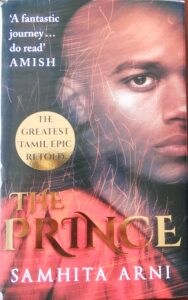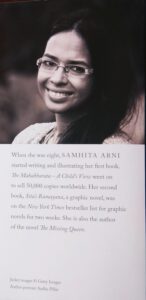Bhaskar Parichha

Whether or not you consider yourself a fan of historical fiction, this genre of writing is gaining respect of critics and readers alike. Regularly appearing on shortlists for major literary awards and on bestseller lists around the world, English historical fictions in India, on the other hand, are few and far between. Samhita Arni’s ‘The Prince’ belongs to that rare faction.
The first thing that would catch one’s attention in the book is the punch-line on cover of the book: ‘The Greatest Tamil Epic Retold.’ The novel is set in a time period in the past and a painstakingly researched work. The famous dancer Madhavi is present at the court of the Chera king for a grand performance. The king’s first son, Shenguttuvan – the crown prince of the Cheras – is getting ready for his engagement to a Velir princess. There is celebration in the air. All of a sudden, an astrologer predicts that the second son Uthiyan is destined to be superior to his elder brother. There is pandemonium in the Chera court. The courtiers begin to play the brothers against each other. Life becomes dangerous for Uthiyan and the prince is forced to run away from his home in the garb of a monk.

On the death-defying journey replete with assassins and conspirators, he is joined by others who seek refuge at the court of the Pandya king. But darkness is descending on the ancient city of Madurai. Warriors from the west, the single-minded and ruthless Kalabhras, have set out to conquer the prosperous Pandya capital and change the face of Tamilaham. Tormented by rage and lust, beset by betrayal and terror, Uthiyan is forced to choose a side in a conflict that is certain to end in bloody violence.
Regardless of how long ago an historical novel takes place, accuracy and authenticity of the historical setting are crucial. Arni seems to have done justice to this essential element. Having done a bit of travelling around, the novel is visually evocative with a gleaming narrative.
A noble prince giving a damn to the temptation of none other than his mother – the Queen, walking away from a cosseted succession to the throne saying it is his estranged brother’s due can not but make it a gripping read. If stories about kings and queens, princes and princesses, royal palaces, kingdoms, wars, betrayals mesmerize the readers, this one is no exception.
Arni’s historical fiction is located in the Tamil country of the famous Cholas, Cheras and Pandyas. As she writes in her note, ‘a series of synchronicities led me to the Silappadikaram –the beloved epic of the Tamils composed by the Chera prince turned ascetic Illango Adigal.’Arni seems to have been developed a fondness for the character – Adigal – and so she names him Uthiyan – after an ancestor of another Chera king.
Being a historical novel, there is more than the obligatory mention of the maritime traditions of the past. Romans and Roman wine frequently find reference in the pages. What’s more, the novel is stuffed with highly entertaining accounts of ‘skullduggery, miscarriage of justice, executions, assassination plots, love affairs, sex, contrition, revenge and poetry.’
Even as heavily leaning on the Tamil epic Silappadikaram, Arni has added her own inimitable feel to the epic. ‘The Prince’ is fast-paced and an absorbing work of fiction with a strong storyline. Regardless of how long ago an historical novel takes place, accuracy and authenticity of the historical setting are crucial. Arni seems to have done justice to this essential element. Having done a bit of travelling around, the novel is visually evocative with a gleaming narrative.
When she was eight, Samhita Arni started writing and illustrating her first book. The Mahabharata – A Child’s View went on to sell 50,000 copies worldwide. Her second book, Sita’s Ramayana, a graphic novel, was on the New York Times bestseller list for graphic novels for two weeks. She is also the author of the novel ‘The Missing Queen’. With such an amazing bio, her story-telling ought to be unblemished.
The language here is lucid and conveys at one fell swoop a lot in between the words: “The truth is this – we are all seekers, for the knowledge that makes us content with our lot, content with what we are, to make peace with the tragedies that befall all of us.” Elsewhere she says, rather philosophically, “We must respond to the new ways, we cannot keep with the traditions of the past merely because they come from the past. If we do so, we destroy ourselves.”
‘The Prince’ – even if it is coming from a young writer – is undoubtedly a page-turner.
The Prince
Samhita Arni
Juggernaut Books,
KS House, 118, Shahpur Jat
New Delhi n110049
Price 499
The reviewer is a senior journalist and Consulting Editor,OdishaPlus




























